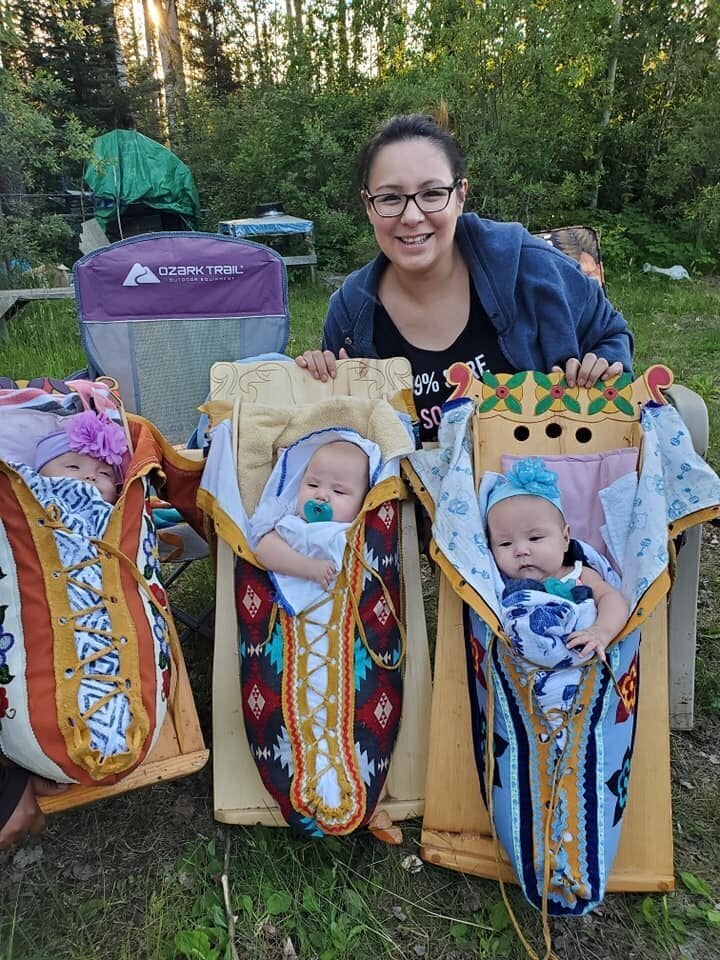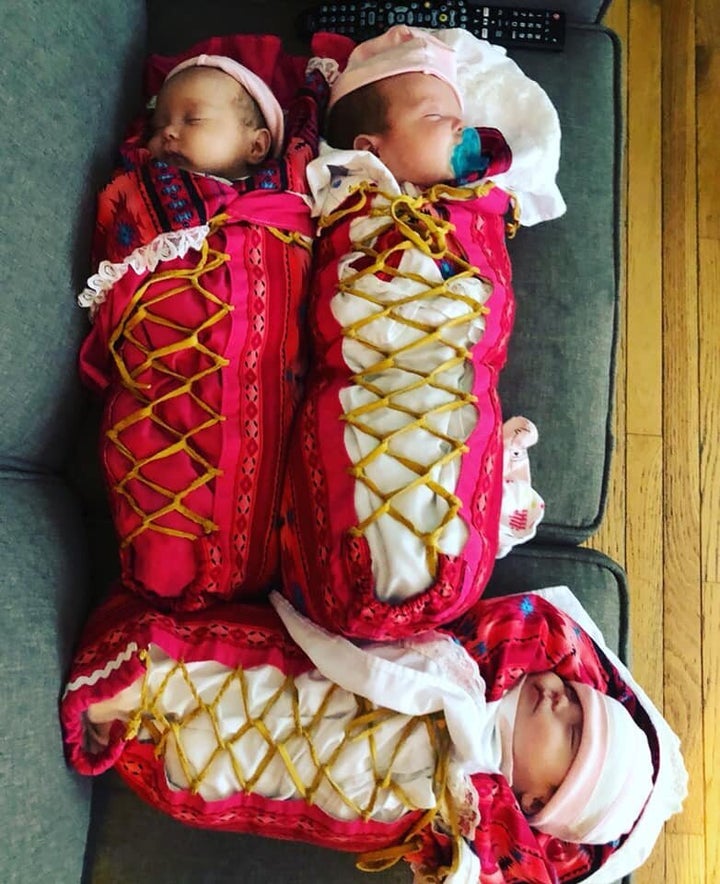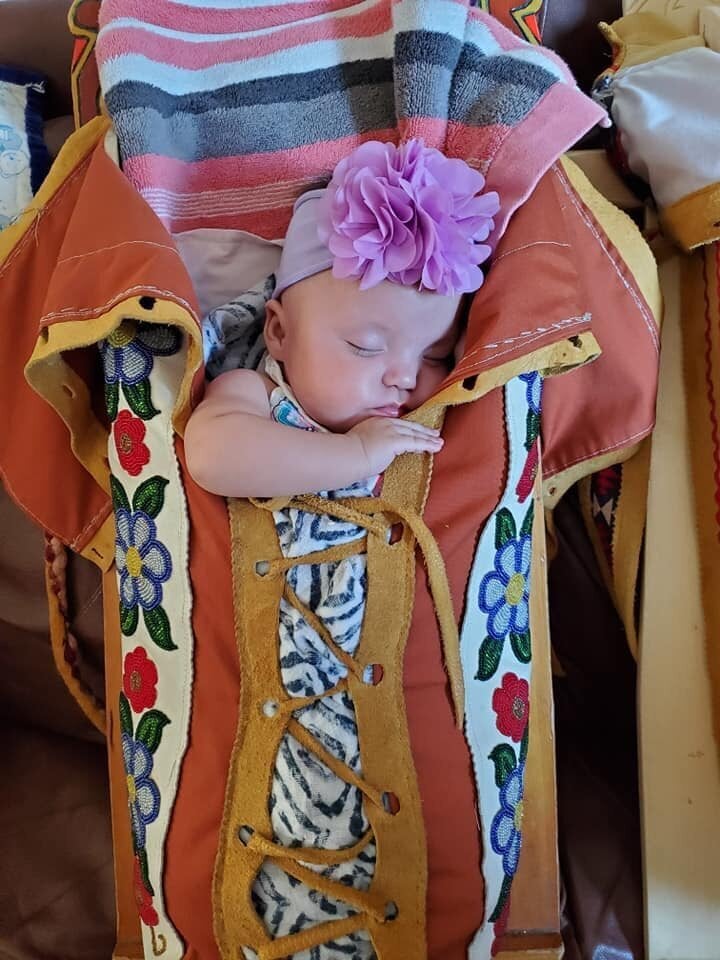Michelle Kakegamic, 34, is from Muskrat Dam First Nation, Ont., a reserve where fewer than 300 people live. But lately, the registered nurse has been the recipient of international attention, receiving dozens of messages and thousands of comments over a family photo.
Kakegamic shared a photo of her triplets with the Facebook page Native Breastfeeding Week, to mark the milestone of breastfeeding them for six months. Many congratulated the mother on her milestone, along with another detail: the handcrafted baby carriers cradling her three daughters.

The Oji-Cree mother told HuffPost Canada she’s thrilled with all the positive attention on her triplets’ baby carriers, known as tikinagans. Her daughters Hiliary Rose, Heather Grace, and Haddison Joy have been carried by tikinagans since they were five weeks old.
The family currently lives in Thunder Bay, Ont., but make the trip back home back often. Kakegamic says that on her reserve, tikinagans are used all the time.
“I just want people to know that this is not an ancient thing … they think tikinagans are not an everyday practice. But it’s still very much alive where we’re from, it’s part of the norm,” she said.
“I just want to pass it on and not lose this practice.”
The joys of tikinagan
A tikinagan, also called a dikinaagan, is a cradleboard that many Indigenous peoples have used to carry their babies. Traditionally, children are swaddled and laced up in a moss bag (the moss’ disinfectant properties served as a diaper).

Then, they’re secured to the wooden cradleboard. Depending on the nation, the tikinagan is decorated with care. Colourful embroidery, meticulous beadwork, vibrant shells, stitching, fringes, and fancy quills can all carry meaning or imbue protection. As renowned tikinagan artist Shannon Gustafson puts it, they can even be free-styled to suit the artist’s preferences.
The tikinagans in Kakegamic’s photo were all handed down from family members. One came from a relative. Another was decorated by the triplets’ godmother. The third, with blue and red floral beadwork, holds a special significance: it was prepared by her cousin, to hold her own child. She never got to see that happen. At the age of 22, Kakegamic’s cousin died of cancer.

Remembering the history a tikinagan can carry is something Kakegamic holds dear.
“It’s not necessarily something you can buy in a store,” she said. “Most [tikinagan] have stories and are passed down through families.”
Better sleep, focus in tikinagans
As for her kids, they get plenty of shut-eye in their tikinagans.
“We use them every single day. Once they see them, they know it’s time for bedtime,” Kakegamic said, laughing. She says her six-year-old son loves singing lullabies to the triplets before they nod off. He was raised in one too.
Kakegamic noticed that her kids sleep longer thanks to the tikinagan. Being in the tikinagan is good for babies, according to the Manitoba First Nations Resource Centre. The benefits they list include better posture, improved sleep, and stimulation from seeing the world from their parent’s point-of-view.
WATCH: Indigenous program helps new parents with mental health. Story continues below.
When it comes to the online response, Kakegamic is happy that others are curious about a child-rearing item that’s part of everyday life in her community. Support from those around the mother has been essential to raising her family.
For instance, breastfeeding for Indigenous mothers is an act Kakegamic advocates for. The alternative wasn’t accessible: formula was expensive up north and Muskrat Dam First Nation had been under a water advisory since 2003. It was thanks to her community’s encouragement — both verbal and through generous helpings of clam chowder — that she’s been able to keep breastfeeding.
Taking back tikinagans
Forced assimilation policies enforced by colonial government rule tore apart Indigenous family structures and undermined child-rearing practices like the tikinagan. So, Indigenous mothers have taken it upon themselves to use the cradle board as a form of connecting to culture and passing it on to their little ones.
Here are a few of our favourite tikinagan photos:
For some parents, their baby’s tikinagan is one they once were cradled in too.
It’s a place for snack time too.
Even baby’s favourite toy can get in on the fun.
Beadwork artist Amanda Fox proved you’re never too old for tikinagans, in a stellar homemade Halloween costume last year.
For those who are Indigenous and hope to make their own tikinagan, but don’t know where to start, attending a workshop can help. Some courses are offered by organizations, while others are run by the artists themselves. A popular recurring workshop is offered by Anishnaabe artists Shannon and Ryan Gustafson, who have taught how to built a tikinagan from scratch across Ontario.
With any baby carrier, Health Canada’s guidelines such as checking your child often and asking for help if you need assistance securing them are important to follow.
More from HuffPost: